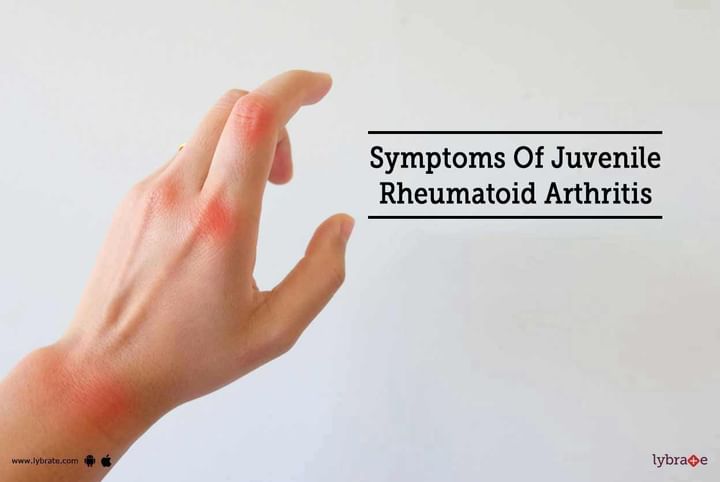Symptoms Of Juvenile Rheumatoid Arthritis
Last Updated: Apr 13, 2020
Definitely, there is pain, swelling and tenderness in joints because of inflammation in joints. A child with juvenile rheumatoid arthritis can have joints that are swelled with redness and warm feeling to the touch in the region of joints. The pain occurring in joints of knees, hips, ankles etc. are inhibiting the movement of child and making it less physically active. This condition if lasted for longer period of time without any treatment can result into complete damage to joints.
Limping (In younger children, it may appear that the child is not able to perform motor skills he or she recently learned.)
Juvenile rheumatoid arthritis is condition mainly affecting the joints of body, especially children. When a child starts walking or performing the motor skills learned during growing age and if he or she is suffering autoimmune diseases then it is very difficult for child to walk properly. This means, there is a chance of development of abnormal walking patterns in which movements like hobbling are occurring. Child may put less pressure on one foot or faces pain or discomfort while walking. In many cases, children are expressing their desire to not walk even though they are able to walk.
Persistent fever
There is a sign of persistent fever in patient suffering from juvenile arthritis as it is one type of autoimmune disease. Fever is a condition when the body temperature gets increased upto 103-104 degree Fahrenheit and this commonly occurs when body produces components to fight against infection or other conditions, but the immunity based cells loses their ability to differentiate between the healthy cells and infectious cells. This leads to damage to healthy cells and inflammation in joints. Once the body’s fighter cells are released, normal temperature of body rises and it is extended for prolonged period till the treatment starts.
Rash
As it is very clear that juvenile rheumatoid arthritis is autoimmune disease, the release cells like cytokines of body’s defensive system can results into light pink or red colored skin rashes. This type of skin rashes can be easily visible at parts of body such as abdomen, chest, hands, feet and back. If this disease represents symptoms like skin rashes, fever along with pain and stiffness in joints etc. then it may be systemic juvenile rheumatoid arthritis and it may continue to till adulthood.
Weight loss
When the inflammation occurs in joints, it further results into pain, swelling and stiffness in affected joints. This condition of Juvenile Rheumatoid arthritis may reduce child’s activity to chew food properly or open the jaw enough to take a bit. On other side, this disease makes food swallowing process also difficult and painful. Due to this, child eats smaller quantities of food or nutritious meals or snacks and finally there will be fewer intakes of calories as compared to daily need of calories by body. At such point, weight loss of child is easily observed and it can be treated with intake of proper diets suggested by dietician as per condition of child.
Fatigue
Fatigue is symptom that is not only linked with one type of disease but it can be one type of indicator for many hidden medical issues. There are full chances of occurrence of fatigue or lack of inability of any activity because pain, swelling, stiffness and inflammation of joints in Juvenile Rheumatoid arthritis can disturb the sleep of patient and patient encounters feeling of being tired all the time. To overcome such condition, child need to be physically active so that body’s sleep cycle gets reset.
Irritability
Juvenile Rheumatoid arthritis may cause fatigue or feeling of tiredness due to disturb sleep cycle. This fatigue can further proceeds and make child frustrated or upset frequently. This sign of irritability can be accompanied with sweating; racing heart, fast breathing, confusion and anger guides the parents as well as medical professionals to diagnose underlying cause. This type of mood change has been also observed in children and treated with talk therapy and medications.
Eye redness or eye pain
Juvenile rheumatoid arthritis is affecting the eyes as inflammation causes redness and pain. This condition of eye is associated with arthritis may lead to particularly sensitivity to light. If this sensitivity prolonged for eyes, it can damage eyes permanently and arises problems of vision. When person continuously experience the redness and pain in eyes, doctors may diagnose this arthritis or inflammation with the help of slit lamp exam. If other symptoms like fever, fatigues, pain in joints, stiffness in joints etc. are occurring along with eye redness and pain, emergency medical treatment is mandatory for patient.
Blurred vision
Juvenile rheumatoid arthritis can promote blurred vision like situations because the body defensive cells are attacking over the healthy tissues of body. If the healthy eye tissues or cells are damaged by such defensive cells, then children may experience symptoms of blurred vision such as squinting. There are episodes of pain and swelling of joints in Juvenile Rheumatoid Arthritis which is happening even after limiting the movement or rest to the body. If a child is suffering from Juvenile Rheumatoid Arthritis then he or she should visit ophthalmologist to detect any problems associated with eyes and vision.
References
- Carter BD, Kronenberger WG, Edwards JF, Marshall GS, Schikler KN, Causey DL. Psychological symptoms in chronic fatigue and juvenile rheumatoid arthritis. Pediatrics. 1999 May 1;103(5):975-9. [Cited 06 April 2020]. Available from:
- Schaller J, Kupfer C, Wedgwood RJ. Iridocyclitis in juvenile rheumatoid arthritis. Pediatrics. 1969 Jul 1;44(1):92-100. [Cited 06 April 2020]. Available from:
- Cleveland SE, Rezitman EE, Brewer Jr EJ. Psychological factors in juvenile rheumatoid arthritis. Arthritis & Rheumatism: Official Journal of the American College of Rheumatology. 1965 Dec;8(6):1152-8. [Cited 06 April 2020]. Available from:
Table of content
Ask a free question
Get FREE multiple opinions from Doctors



